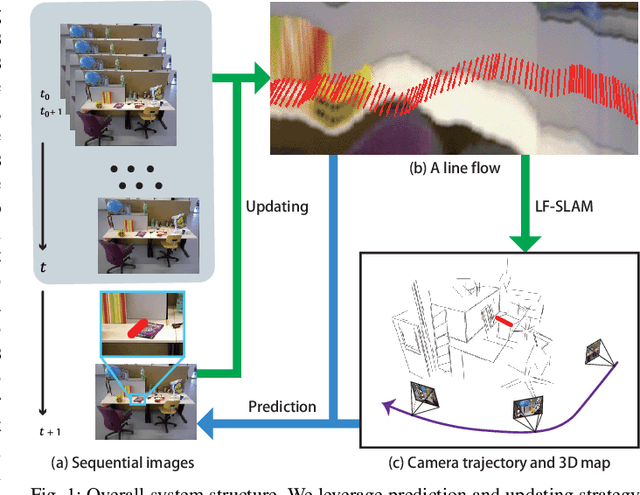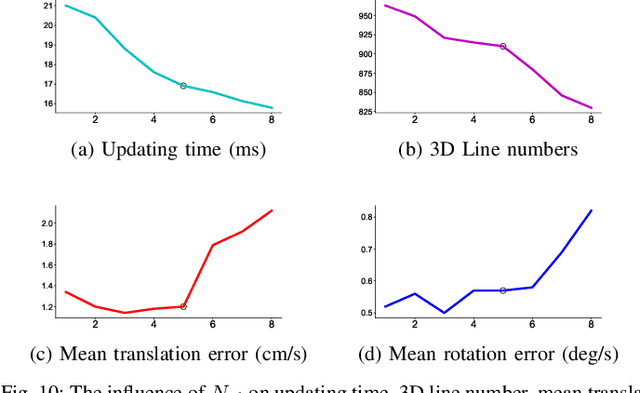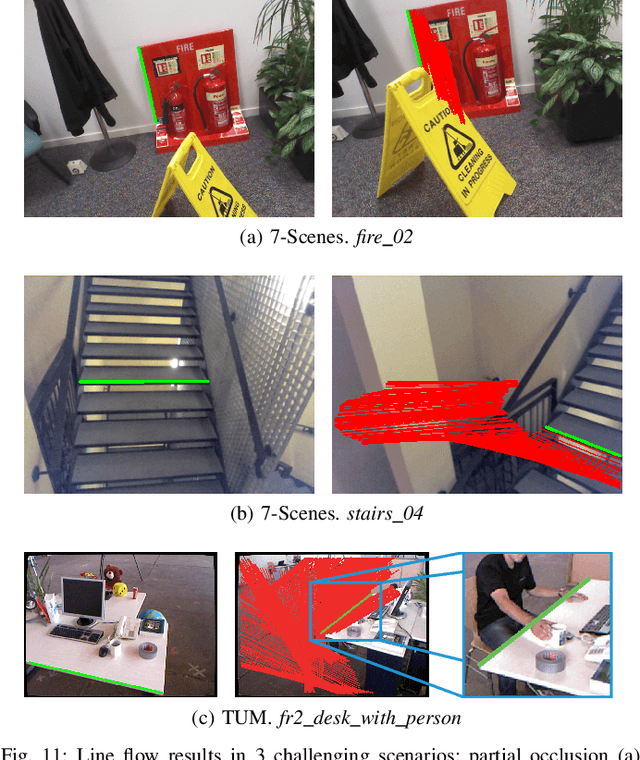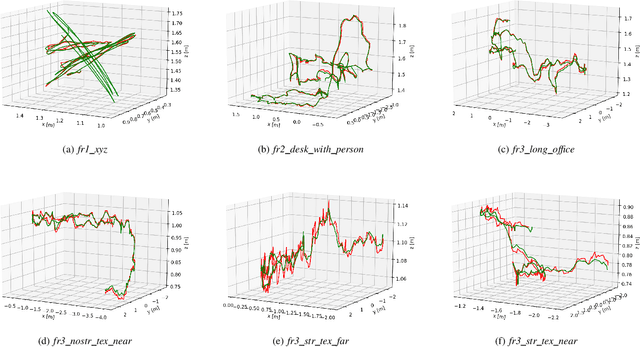Junqiu Wang
Line Flow based SLAM
Sep 21, 2020



Abstract:We propose a method of visual SLAM by predicting and updating line flows that represent sequential 2D projections of 3D line segments. While indirect SLAM methods using points and line segments have achieved excellent results, they still face problems in challenging scenarios such as occlusions, image blur, and repetitive textures. To deal with these problems, we leverage line flows which encode the coherence of 2D and 3D line segments in spatial and temporal domains as the sequence of all the 2D line segments corresponding to a specific 3D line segment. Thanks to the line flow representation, the corresponding 2D line segment in a new frame can be predicted based on 2D and 3D line segment motions. We create, update, merge, and discard line flows on-the-fly. We model our Line Flow-based SLAM (LF-SLAM) using a Bayesian network. We perform short-term optimization in front-end, and long-term optimization in back-end. The constraints introduced in line flows improve the performance of our LF-SLAM. Extensive experimental results demonstrate that our method achieves better performance than state-of-the-art direct and indirect SLAM approaches. Specifically, it obtains good localization and mapping results in challenging scenes with occlusions, image blur, and repetitive textures.
Deep Visual Odometry with Adaptive Memory
Aug 02, 2020Abstract:We propose a novel deep visual odometry (VO) method that considers global information by selecting memory and refining poses. Existing learning-based methods take the VO task as a pure tracking problem via recovering camera poses from image snippets, leading to severe error accumulation. Global information is crucial for alleviating accumulated errors. However, it is challenging to effectively preserve such information for end-to-end systems. To deal with this challenge, we design an adaptive memory module, which progressively and adaptively saves the information from local to global in a neural analogue of memory, enabling our system to process long-term dependency. Benefiting from global information in the memory, previous results are further refined by an additional refining module. With the guidance of previous outputs, we adopt a spatial-temporal attention to select features for each view based on the co-visibility in feature domain. Specifically, our architecture consisting of Tracking, Remembering and Refining modules works beyond tracking. Experiments on the KITTI and TUM-RGBD datasets demonstrate that our approach outperforms state-of-the-art methods by large margins and produces competitive results against classic approaches in regular scenes. Moreover, our model achieves outstanding performance in challenging scenarios such as texture-less regions and abrupt motions, where classic algorithms tend to fail.
Local Supports Global: Deep Camera Relocalization with Sequence Enhancement
Aug 06, 2019



Abstract:We propose to leverage the local information in image sequences to support global camera relocalization. In contrast to previous methods that regress global poses from single images, we exploit the spatial-temporal consistency in sequential images to alleviate uncertainty due to visual ambiguities by incorporating a visual odometry (VO) component. Specifically, we introduce two effective steps called content-augmented pose estimation and motion-based refinement. The content-augmentation step focuses on alleviating the uncertainty of pose estimation by augmenting the observation based on the co-visibility in local maps built by the VO stream. Besides, the motion-based refinement is formulated as a pose graph, where the camera poses are further optimized by adopting relative poses provided by the VO component as additional motion constraints. Thus, the global consistency can be guaranteed. Experiments on the public indoor 7-Scenes and outdoor Oxford RobotCar benchmark datasets demonstrate that benefited from local information inherent in the sequence, our approach outperforms state-of-the-art methods, especially in some challenging cases, e.g., insufficient texture, highly repetitive textures, similar appearances, and over-exposure.
Beyond Tracking: Selecting Memory and Refining Poses for Deep Visual Odometry
Apr 05, 2019



Abstract:Most previous learning-based visual odometry (VO) methods take VO as a pure tracking problem. In contrast, we present a VO framework by incorporating two additional components called Memory and Refining. The Memory component preserves global information by employing an adaptive and efficient selection strategy. The Refining component ameliorates previous results with the contexts stored in the Memory by adopting a spatial-temporal attention mechanism for feature distilling. Experiments on the KITTI and TUM-RGBD benchmark datasets demonstrate that our method outperforms state-of-the-art learning-based methods by a large margin and produces competitive results against classic monocular VO approaches. Especially, our model achieves outstanding performance in challenging scenarios such as texture-less regions and abrupt motions, where classic VO algorithms tend to fail.
Guided Feature Selection for Deep Visual Odometry
Nov 25, 2018



Abstract:We present a novel end-to-end visual odometry architecture with guided feature selection based on deep convolutional recurrent neural networks. Different from current monocular visual odometry methods, our approach is established on the intuition that features contribute discriminately to different motion patterns. Specifically, we propose a dual-branch recurrent network to learn the rotation and translation separately by leveraging current Convolutional Neural Network (CNN) for feature representation and Recurrent Neural Network (RNN) for image sequence reasoning. To enhance the ability of feature selection, we further introduce an effective context-aware guidance mechanism to force each branch to distill related information for specific motion pattern explicitly. Experiments demonstrate that on the prevalent KITTI and ICL_NUIM benchmarks, our method outperforms current state-of-the-art model- and learning-based methods for both decoupled and joint camera pose recovery.
 Add to Chrome
Add to Chrome Add to Firefox
Add to Firefox Add to Edge
Add to Edge